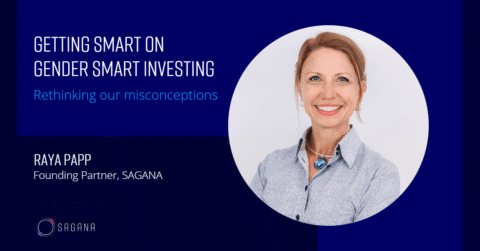Around the world today, there will be many discussions about efforts to empower women and girls, drive gender parity and raise awareness about gender discrimination. Within the finance sector, these conversations continue to evolve and develop, and pleasingly, we know that increasingly more institutional investors are paying attention to gender-smart investing as an opportunity to not only deliver social impact but also generate higher financial returns. And we know there is still lots to be done.
Through our work over the past decade helping asset managers and their portfolio companies, financial institutions and international development organizations integrate a gender lens throughout their investment process and organization, we’ve seen not only the impact on outcomes for women and more broadly the social and environmental impact gender-smart investing can have, but also how it translates to financial outperformance for companies.
While it’s heartening to see increasing attention being dedicated to this field, it’s clear from our conversations that many investors feel overwhelmed by the perceived size of the task. But gender-smart investing is not a destination in and of itself. We don’t suddenly arrive at being gender-smart by achieving a one-off goal; instead, it is an ongoing journey through which we continually strengthen our processes and realign our thinking to ensure the impact we are having is long-lasting and positive for all stakeholders: women, girls, those with other dimensions of diversity, and also men.
This journey starts with awareness: recognizing that we need a new approach to investing and identifying small steps that can drive change and ultimately deepen our impact on human and planetary health. In my experience working with investors, foundations, development organizations and even entrepreneurs, common blind spots seem to come up time and time again, preventing action from being taken. By better understanding them and identifying where our assumptions are influencing behavior, we can overcome these misconceptions and open up significant opportunities for our businesses and for women.
Misconception #1: There aren’t enough women candidates to hire.
A US healthcare growth equity firm I worked with aimed to hire a female associate to improve its diversity, as 90% of the firm was male. When the hiring manager received only a few applications from female candidates, his conclusion was that there weren’t enough female candidates out there.
Yet there are female investment professionals out there – our firm and firms we work with, such as Circulate Capital, have gender-balanced investment teams at all levels of seniority. Women want to join firms where they can see that people like them can grow, advance and lead. When they don’t see that either in the current composition of the company or in the company’s recruiting efforts – they don’t even bother to apply. Why would they? Today more than ever, they have plenty of choice.
We know from research that gender-balanced investment teams generate 10-20% higher returns for PE and VC firms. And more diverse teams open new deal pipelines and sub-sectors. Diversity is worth the effort – and it gets easier as your team better reflects the diversity you want to see in applicants.
Even if you haven’t already reached the diversity you would like to see at the top, being vocal about your intentions is a clear way to signal that you’re looking to change. There is a raft of simple ways to help increase the women candidates in your pipeline, like making job postings more inclusive (yes, there is a difference in word choice and there is software such as Develop Diverse that can quickly and easily help), adding a statement about your commitment to diversity on your website (only if it’s authentic), sharing more success stories about women at your organization and including women (at any level) in meetings or decisions that would otherwise not have the benefit of a female (or diverse) perspective, whether it’s on environmental policies, investment processes or hiring decisions.
No single strategy will act as a silver bullet, but prioritizing the representation of women, clearly stating your diversity intentions and rethinking some of your existing approaches can help combat this misconception and attract the plethora of women candidates that are, actually, out there.
Misconception #2: It’s tough to find female entrepreneurs.
It’s common to hear from investors that it is difficult to find female entrepreneurs in a specific, male-dominated sector or even to find women who have reached for example, Series C scale. While there are certainly many sectors and markets in which women are underrepresented as entrepreneurs, this is often a case of networks. If your network doesn’t already include a wide diversity of people, it’s much less likely that you are going to find people who are different from you.
In general, we find investors typically do not have the networks that allow them to build pipeline with investable women entrepreneurs or co-founders. This is something that needs to change. Rather than placing the onus on women entrepreneurs to change their abilities, successes or the growth of their companies, investors can change the way that their networks are cultivated.
Contrary to popular belief, women’s networks are not only for women. Most, if not all, are willing and openly encouraging of male champions and partners. Beyond that, these networks are excellent to tap for new deal sourcing. In the example of our client Cartier Women’s Initiative, over the last six years, we’ve been able to meet and assess thousands of businesses that are founded and led by women. This is where gender-smart investing becomes really exciting for investors: finding great companies among populations that no one else is exploring by building relationships in new networks.
Ultimately, until you have a diverse investment team, intentionally reaching out to new networks is a fantastic step to take towards finding and eventually investing in excellent female entrepreneurs.
Misconception #3: Gender-smart investing means a lot of extra work on top of an already overloaded organization.
Understandably, investors considering gender lens investing are often under the impression that it requires a new set of technical expertise to become gender-smart. The idea of dedicating significant time to training or further education can be a significant barrier for busy investors. However, there are other approaches that investors can more easily take.
Gender-smart investing does require specific analytical techniques and expertise, but building capacity can start by simply evaluating your investment process alongside consultants or peers who are more advanced. They can help evaluate where you’re starting and identify what opportunities are in front of you.
When working with fund manager, EcoEnterprises, we found that a straightforward toolkit helped arm the firm’s investment officers. We incorporated these tools in the existing investment documents rather than adding new ones. We also shared due diligence questions that kickstarted conversations with portfolio companies about their gender impact. This on-the-job approach and training was simple to incorporate into the team’s everyday processes rather than requiring additional time to achieve deep expertise or hiring a new person.
Misconception #4: Gender-smart investing is only about women.
Historically, gender-smart investing has focused very singularly on women, and as some critical voices have noted, is led predominantly by white women from the global north. However, increasingly the industry is expanding to include a greater consideration of other minorities and intersectional groups including race and sexuality. Although we still have a long way to go, investors are making a conscious effort to understand how we can design and create more inclusive systems – those that help not just women or girls, but all populations that do not have equal capital allocation privileges or representation in our traditional structures and institutions.
As investors, this process is, at its core, about our work understanding companies: their strategies, markets, teams and opportunities, as well as risks they might not consider themselves. As we make changes and strengthen the investment process, the questions that we ask companies can help shape thinking about the different profiles of people their business is serving, not just women and girls, but also other minority and disadvantaged populations. This is not a stretch to what we do all the time and is a skill anyone can learn.
Where the gender-smart journey begins is understanding where our assumptions and blind spots are preventing us from taking a more inclusive approach to investing – and spotting risks and opportunities we would otherwise miss. Once we recognize this, any and all of these small steps on the journey will help us maximize the impact we have on not only financial returns, but also human and planetary health.





